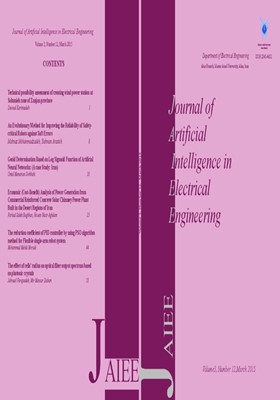The reduction coefficient of PID controller by using PSO algorithm method for Flexible single-arm robot system
محورهای موضوعی : journal of Artificial Intelligence in Electrical Engineering
1 -
کلید واژه: PSO, PID, single-arm robot, reduction of coefficients,
چکیده مقاله :
This study on the design of PID controllers for flexible single-arm robot system optimizationPSO method is focused so that the coefficients of the PID controller are reduced. In this study,PID controller and PSO algorithm have been described and then by using MATLAB, PIDcontrol was simulated. Then by PSO algorithm, attempts to reduce the PID coefficients are givenby simulation. Finally PID coefficients' values were compared with and without the PSOalgorithm. The results showed that by using the number of birds and birds number steps, bothequal to 30 (the sixth), the lowest values of the coefficients p K , d K , i K are 0.741, 0.1491and0, respectively.
[1] Betin F., Pinchon D., and Capolino G. (2000).
“Fuzzy logic applied to speed control of a
stepping motor drive,” IEEE Transactions on
Industrial Electronics, vol. 47, pp.610-622.
[2] Qingding G. and Yanna S. (2000). “H control
based on internal model theory for linear
permanent magnet synchronous servo motor
(LPSM),” Control Theory & Applications,
vol.17, pp. 509-512.3
[3] Satyobroto Talukder (2011). Mathematical
Modelling and Applications of Particle Swarm
Optimization, Submitted to the School of
Engineering at Blekinge Institute of Technology
In partial fulfillment of the requirements ,
Department of Mathematics and Science.
[4] Betin F., Pinchon D., and Capolino G.
(2000). “Fuzzy logic applied to speed
control of a stepping motor drive,” IEEE
Transactions on Industrial Electronics, vol.47,
pp.610-622.
[5] Systematic Design Approach for a New Series
of Ultra‐NEMA Premium Copper Rotor Motors,
by Fuchsloch, J. and E.F. Brush (2007), in
EEMODS 2007 Conference Proceedings, 10‐15
June,Beijing.
[6] Kalman, R.E. (1960). “A New Approach to
Linear Filtering and PredictionProblems,”
Transactions of the ASME--Journal of Basic
Engineering, vol.82,pp. 35-45.
[7] Stengel R., “Optimal Control and Estimation:
First Edition,” Dover Publication, Inc., New
York.
[8] Behal A., Feemster M., Dawson D., and Mangal
A. (2000). “Sensorless Rotor Velocity Tracking
Control of the Permanent Magnet Stepper
Motor,” Proceedings of the IEEE International
conference on Control Applications, pp. 150-
154, Alaska, September.
[9] Simon D. (2000). “Design and rule base
reduction of a fuzzy filter for the estimation of
motor currents,” International Journal of
Approximate Reasoning, pp. 145-167.
[10] Crnosija P., Kuzmanvoic B., and Ajdukovic S.
(2000). “Microcomputer implementation of
optimal algorithms for closed-loop control of
hybrid stepper motor drives,” IEEE Transactions
on Industrial Electronics, vol. 47, pp. 1319-
1325.
[11] A.Nabae, S. Ogasawara, and H. Akagi, (1986)
“A Novel Control Scheme for Current-
Controlled PWM Inverters,” IEEE
Transactions on Industry Applications, vol. IA-
22, pp. 697-701, July/Aug.
[12] Araki M., Control Systems, Robotics, and
Automation – Vol. II - PID Control -,Kyoto
University, Japan.
[13] Gaing Z. L., (2004). A particle swarm
optimization approach for optimum design of
PID controller in AVR system, IEEE Trans.
Energy Conversion, vol. 19, p. 384 –391.
[14] Kim T. H., Maruta I., Sugie T. (2008). Robust
PID controller tuning based on the constrained
particle swarm optimization, Automatica, Vol.
44, Issue 4, p. 1104 – 1110.
[15] Akbari, M., et al. "Nonlinear H∞ controller for
flexible joint robots with using feedback
linearization." International Journal on
Computer Science and Engineering (IJCSE),
ISSN (2011): 0975-3397.
[16] Pourmahmood, Mohammad, Mohammd Esmaeel
Akbari, and Amin Mohammadpour. "An
efficient modified shuffled frog leaping
optimization algorithm." Int. J. Comput.
Appl 32.1 (2011): 0975-8887.
[17] Akbari, M. E., M. A. Badamchizadeh, and M. A.
Poor. "Implementation of a fuzzy TSK
controller for a flexible joint robot." Discrete
Dynamics in Nature and Society 2012 (2012).


